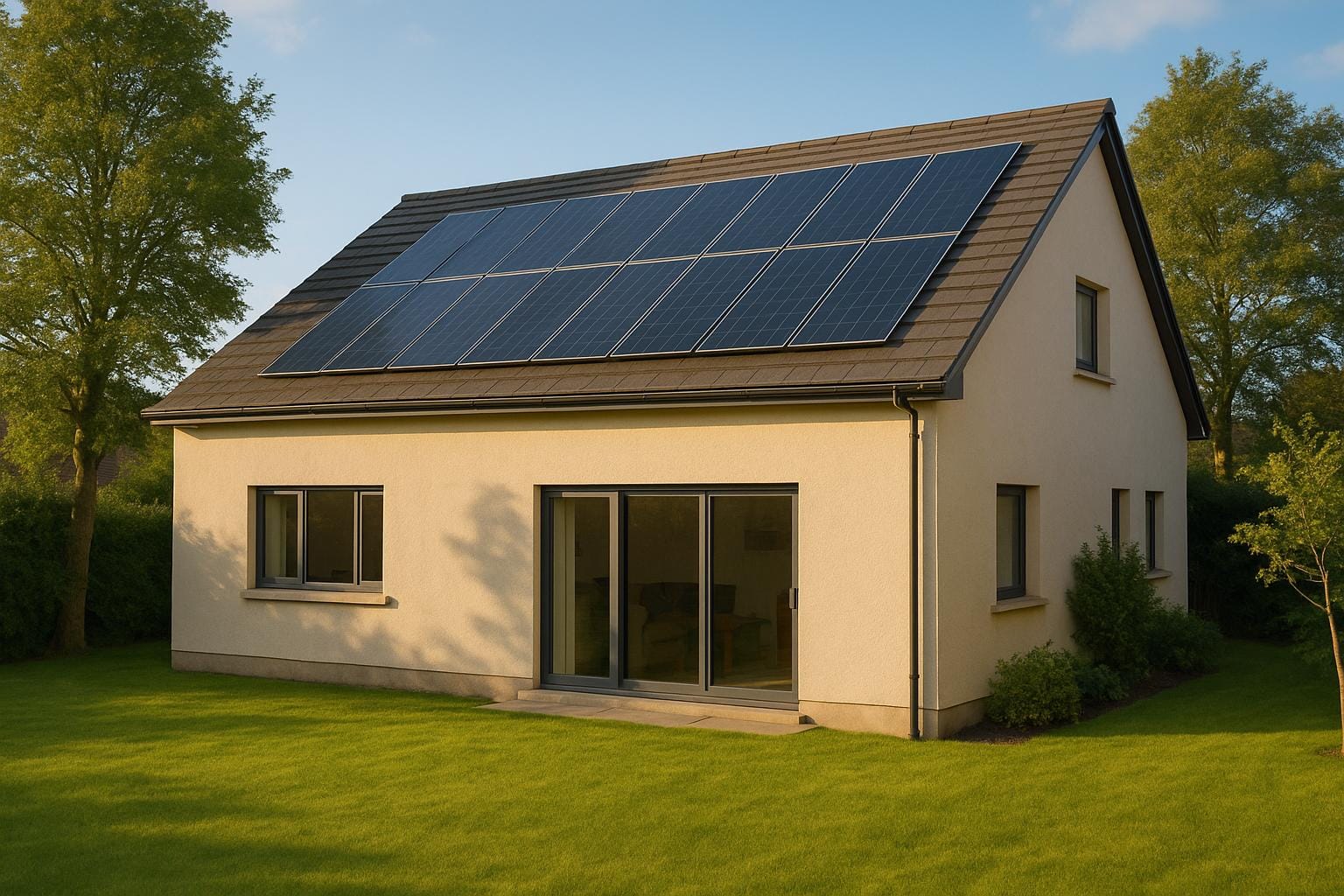New Planning Permission Exemptions for Solar Panels
Ireland has simplified solar panel installations by removing planning permission requirements, promoting renewable energy adoption across homes and businesses.

Ireland has made it simpler for property owners to install solar panels by removing many planning permission requirements. Here’s what you need to know:
- Homeowners can now install rooftop solar panels without size limits, even in regulated zones.
- Businesses, farms, and other non-domestic buildings can install up to 3,230 ft² of panels per building without permission.
- Free-standing and wall-mounted systems have specific size limits based on property type.
- Solar Safeguarding Zones (near airports) have minor restrictions but still allow significant installations.
These changes, effective since October 2022, aim to help Ireland meet ambitious solar energy targets by 2030, reduce CO₂ emissions, and lower energy costs for households and businesses. Grants and zero-VAT options further reduce installation costs, making solar energy more accessible.
Now, property owners can install solar panels faster and cheaper, contributing to a cleaner energy future.
Do You Need Planning Permission for Solar Panels?
What Changed in Planning Permission Rules
In October 2022, Ireland introduced regulatory updates that eliminated many planning permission requirements for solar installations. This shift simplifies the process for installing solar panels and represents a significant step forward in Irish solar energy policy. Below, the updated rules for various installation types are outlined.
Rooftop Solar Panels
Before these updates, homeowners could only install up to 129 ft² (approximately 12 m²) or cover 50% of their roof area with solar panels without needing planning permission. The new rules have completely removed these restrictions for houses. Now, homeowners can install solar panels across their entire roof - whether the property is inside or outside a Solar Safeguarding Zone. This change allows residents to maximize their home's solar capacity without any bureaucratic hurdles.
Non-Domestic Buildings
The exemptions now extend well beyond residential properties. Apartment buildings, businesses, industrial sites, farms, community centers, sports facilities, and more can install solar panels without planning permission in most areas. For non-domestic buildings, the rooftop limit is set at 3,230 ft² (approximately 300 m²). Even in Solar Safeguarding Zones, which cover less than 3% of Ireland’s land area, the same 3,230 ft² limit applies. These allowances provide ample room for large-scale solar installations, even in regulated zones.
Free-Standing and Wall-Mounted Solar Panels
The updated rules also address free-standing and wall-mounted solar panel systems, offering more flexibility for properties where rooftop installations may not be practical.
- For houses: Homeowners can install up to 269 ft² (approximately 25 m²) of free-standing solar panels without planning permission, as long as at least 269 ft² of private open space remains. This option is particularly useful for properties with limited roof space due to shading or structural constraints.
- For other buildings (excluding apartments): Up to 807 ft² (approximately 75 m²) of free-standing panels can be installed without planning permission.
- Wall-mounted panels: Industrial and agricultural buildings are allowed up to 646 ft² (approximately 60 m²) of wall-mounted solar panels.
To ensure installations remain discreet, free-standing panels must not exceed a height of 6.6 ft (approximately 2 m). This height limit also facilitates maintenance and prevents visual obstructions.
Minister Peter Burke highlighted the practical benefits of these changes:
"These draft regulations will help facilitate the rollout of rooftop solar energy across the country. They will enable individuals, communities, businesses and farms to play their part in creating a future fuelled by renewable energy and acting against climate change. They will help people and businesses to reduce their energy bills and increase Ireland's energy security, a major challenge given developments in Europe and the need to rapidly reduce dependence on Russian fossil fuels".
These new rules, effective from October 7, 2022, have opened the door to widespread solar adoption across Ireland. They align with the country's renewable energy targets and initiatives like the EU's Solar Rooftops Initiative, making solar energy more accessible and practical for everyone.
Who Qualifies for Exemptions
The updated planning permission exemptions simplify the process for installing solar panels, making it easier for most property owners to proceed without unnecessary delays.
Property Types That Qualify
Houses are entirely exempt from planning permission requirements. Homeowners can install solar panels across their entire rooftop without needing any additional approvals.
Commercial and institutional buildings - including community centers, schools, places of worship, healthcare facilities, libraries, and recreational spaces - can install up to 3,230 ft² (300 m²) of rooftop solar panels without requiring planning permission.
Business and industrial properties also benefit from the same 3,230 ft² allowance. If a property has multiple buildings, this limit applies to each structure individually.
Agricultural buildings are allowed to install rooftop solar systems up to the standard 3,230 ft² (300 m²) limit per building as well.
However, properties classified as protected structures or located in Architectural Conservation Areas may still require planning permission for solar panel installations.
Next, let’s look at how Solar Safeguarding Zones impact these exemptions.
Solar Safeguarding Zones
Solar Safeguarding Zones (SSZs) are specific areas near airports, aerodromes, and helipads where solar panel glare could interfere with aviation safety. Ireland has designated 43 such zones, covering less than 2% of the country’s total land area.
Within these zones, houses retain their unlimited rooftop solar capacity. For other property types, the 3,230 ft² limit still applies. If a planned installation exceeds this limit, property owners must apply for planning permission through their local planning authority.
To check whether your property is in a Solar Safeguarding Zone, visit MyPlan.ie. If your property falls within an SSZ, working with experienced solar installers familiar with local regulations can help ensure compliance with any additional requirements.
With Solar Safeguarding Zones covering such a small portion of land, the vast majority of properties can take full advantage of these new exemptions, advancing renewable energy efforts while prioritizing aviation safety.
Benefits of the New Rules
The updated planning permission exemptions bring clear advantages for property owners and the renewable energy sector as a whole.
Old Rules vs New Rules
Comparing Ireland's previous and current planning requirements reveals a major shift toward simplicity and accessibility.
| Property Type | Old Rules | New Rules |
|---|---|---|
| Houses | Maximum 129 ft² (12 m²) or 50% roof coverage | Unlimited rooftop solar panels |
| Commercial/Industrial Buildings | Maximum 538 ft² (50 m²) | Up to 3,230 ft² (300 m²) per building |
| Agricultural Buildings | Required planning permission for most installations | Up to 3,230 ft² (300 m²) per building |
| Free-Standing/Wall-Mounted | Limited exemptions | Up to 646 ft² (60 m²) exemptions |
Under the old rules, rooftop solar installations were capped at just 129 ft², making it difficult to generate meaningful energy. The new regulations remove these restrictions, allowing for larger installations that save both time and money.
Cost and Time Savings
By eliminating the need for planning permission, property owners can now avoid unnecessary expenses and delays.
- Financial Relief: Previously, obtaining planning permission meant paying fees and hiring specialists for consultations. These costs are now a thing of the past.
- Time Efficiency: The lengthy approval process often delayed projects, adding frustration for property owners eager to install solar panels.
- Reduced Risk: Before October 2022, there was always the chance that planning applications could be rejected, even after significant time and money had been spent on research and equipment.
"I am delighted to see these exemptions finally signed into law with immediate effect. This will remove unnecessary costs and complexity that has come with installing solar panels until now."
– Steven Matthews, Green Party TD and Chair of the Oireachtas Committee on Housing
In addition to these immediate benefits, the new framework supports broader environmental and economic goals.
Impact on Environment and Economy
The updated rules not only simplify the process but also help Ireland meet its renewable energy targets while boosting economic activity in the solar sector.
- Accelerating Renewable Energy: By cutting through red tape, the exemptions enable Ireland to advance its commitments under the EU Solar Rooftops Initiative. Homeowners can now utilize their entire roof for solar panels, while businesses and other non-domestic properties benefit from much higher capacity limits. These changes are a big step forward in Ireland's transition to renewable energy.
- Economic Growth: A more straightforward regulatory process encourages investment in solar technology and installation services. Farmers, schools, and community groups can now move forward with solar projects without paying for costly planning consultants, freeing up funds for larger or more energy-efficient systems.
"Until this bill was passed today, farmers, schools and communities had to go through expensive and tedious planning permission to install solar panels to make their own electricity. As of today, that is no longer the case."
– Senator Róisín Garvey, Green Party Spokesperson for Rural Development, Enterprise, Trade and Employment
- Energy Independence: Minister Darragh O'Brien highlighted the strategic importance of these changes:
"With these new exemptions we are eliminating obstacles to self-generated electricity and ensuring that individuals, communities, businesses and farms can generate their own electricity, reduce their own bills and play their part in creating a zero-carbon future fuelled by renewable energy"
These exemptions are especially impactful for the agricultural and industrial sectors. With the expanded capacity per building, businesses and farms can install larger systems, cutting energy costs while contributing to Ireland's renewable energy goals.
How to Install Solar Panels Under New Rules
Ireland's updated planning permission exemptions make it easier than ever to install solar panels. To get started, you'll need to understand the new rules, check if your property qualifies, and follow the necessary steps to ensure compliance.
Check If You Qualify
The new rules have simplified the process for homeowners. Now, you can install as many solar panels as you like on your rooftop without needing planning permission, regardless of your location. This replaces the previous limit of 12 m².
"Houses, regardless of location, will now be able to have solar panels installed on their roofs without any requirement for planning permission, which I know will be very welcome to many homeowners." – Minister of State Peter Burke
For ground-mounted systems, there are size limits based on property type. Homeowners can install up to 25 m² if they have enough private open space, while other properties (excluding apartments) can go up to 75 m². Industrial and agricultural buildings have a 75 m² limit for wall-mounted systems. Properties with heritage restrictions may require additional consultation - your local Conservation Officer or planning authority can provide guidance under section 5 of the Planning and Development Act 2000.
Once you confirm your property qualifies, you can explore financial incentives to make the installation more affordable.
Available Grants and Incentives
The Irish government provides substantial financial support through SEAI grants, which can significantly reduce the cost of installing solar panels. These grants range from €1,218 ($1,316) for smaller systems to €1,800 ($1,944) for larger setups, as shown below:
| Number of Solar Panels | Solar PV System Output | Grant Value |
|---|---|---|
| 4 panels | 1.74kWp | €1,218 ($1,316) |
| 6 panels | 2.61kWp | €1,522 ($1,644) |
| 8 panels | 3.48kWp | €1,698 ($1,835) |
| 10 panels | 4.35kWp | €1,800 ($1,944) |
| 12 panels | 5.22kWp | €1,800 ($1,944) |
| 16 panels | 6.96kWp | €1,800 ($1,944) |
As of May 10, 2023, zero-VAT installations are available, removing the tax on both supply and installation. When combined with SEAI grants, the average cost of installation drops from €5,500–€10,500 (around $5,940–$11,340) to a more affordable range of €4,250–€8,700 ($4,590–$9,396).
Farmers can access even more generous support, with grants covering up to 60% of costs or a maximum of €90,000 (about $97,200) for on-farm solar systems. Additionally, solar thermal collectors are eligible for a grant of €1,200 ($1,296). Keep in mind, these grants will gradually decrease each year, with plans to phase them out entirely by 2029. To qualify for SEAI incentives, your property must have been built and occupied before December 31, 2020.
Before starting, apply for SEAI grants online or by mail. It's also a good idea to get multiple quotes from SEAI-registered installers. Make sure your chosen installer handles the grid connection application with ESB Networks.
With funding sorted, the next step is finding the right professional to install your system.
Finding Solar Panel Installers
Hiring a qualified installer ensures your system meets all regulations and operates efficiently. A great resource is Get Solar Panels (https://getsolarpanels.ie), which connects property owners in Ireland with experienced professionals familiar with the latest planning requirements.
SEAI-registered installers are essential for accessing government grants. They also handle key tasks like notifying authorities in Solar Safeguarding Zones, arranging post-installation Building Energy Rating (BER) assessments, and setting up feed-in tariffs for selling excess power back to the grid.
When choosing an installer, always check their SEAI registration and experience with your type of property. With the simplified planning process, you can focus on getting a high-quality solar system installed by professionals who will guide you every step of the way.
Conclusion
Ireland's updated planning permission exemptions mark a major step forward in expanding renewable energy use, particularly through solar panel adoption. By removing the 12 m² cap, homeowners can now maximize their rooftop space, while schools, community centers, and farms gain new opportunities to cut energy costs and contribute to national climate goals.
These changes align with Ireland's ambitious target of generating 380MW of microgeneration capacity - around 1 million solar panels - as part of the broader goal to reach 2.5GW of solar electricity by 2030 under the Government's Climate Action Plan. Additionally, with the government recently increasing solar targets to 5.5GW by 2030, these reforms couldn't come at a better time.
The benefits go beyond environmental impact. Property owners save both time and money by bypassing lengthy planning processes and can take advantage of financial incentives. This streamlined approach also ties Ireland to the EU Solar Rooftops Initiative, further cementing its role as a leader in renewable energy.
With solar safeguarding zones affecting less than 3% of Ireland's land area, most properties can proceed with solar installations without concern. Whether you're a homeowner aiming to lower energy bills, a farmer exploring additional revenue options, or a business striving for sustainability, these updates make solar energy more accessible than ever. By supporting national climate goals, these reforms empower all sectors to actively participate in building a greener future.
"The signing of these regulations represents the achievement of one of our major Climate Action Plan ambitions...The regulations remove a major barrier to those wishing to install solar PV, and will facilitate an even greater number of households, schools, communities, farmers and businesses, among others, to produce their own clean, renewable electricity and play an active role in the energy transition." – Minister Eamon Ryan
FAQs
What are the size restrictions for solar panel systems under the new planning exemptions?
Under the new planning rules, both free-standing and wall-mounted solar panel systems can now cover up to 300 square meters per rooftop. The goal is to streamline the process of going solar while keeping installations practical and safe for different types of buildings.
For homeowners and businesses across Ireland, this update removes the hassle of obtaining planning permission, making it simpler to embrace solar energy and contribute to a greener future.
How do the new planning exemptions affect the cost and ease of installing solar panels for property owners?
Recent updates to Irish planning laws have simplified the process for installing solar panels by eliminating the need for planning permission in many cases. This change cuts through red tape, saving property owners both time and money when setting up solar systems.
With these regulatory hurdles out of the way, installing solar panels has become a more practical and cost-effective option for homeowners and businesses alike. The new rules are particularly helpful for rooftop installations, making the process quicker and less expensive, which could lead to a wider adoption of solar energy across the country.
What are Solar Safeguarding Zones, and why do they matter for solar panel installations near airports?
Solar Safeguarding Zones (SSZs)
Solar Safeguarding Zones (SSZs) are designated areas surrounding airports and airfields, typically spanning a 2 to 3-mile radius. These zones are established to maintain aviation safety by minimizing risks like glare or reflections from solar panels, which could distract or impair pilots during flight operations.
For anyone considering solar panel installation near an airport, it's crucial to determine if your property lies within an SSZ. Solar projects in these zones may face restrictions or require special approvals to ensure they don't interfere with aircraft navigation or safety protocols. To stay compliant, always review local regulations and guidelines before proceeding.

